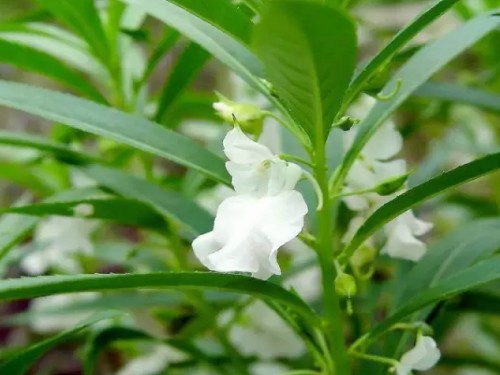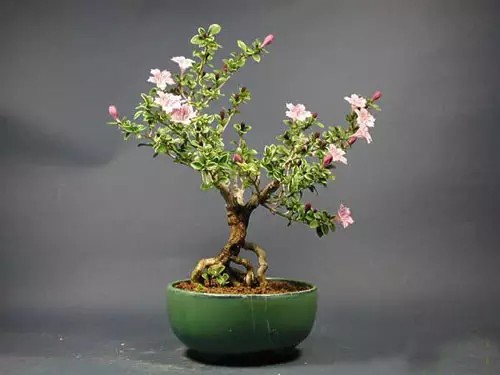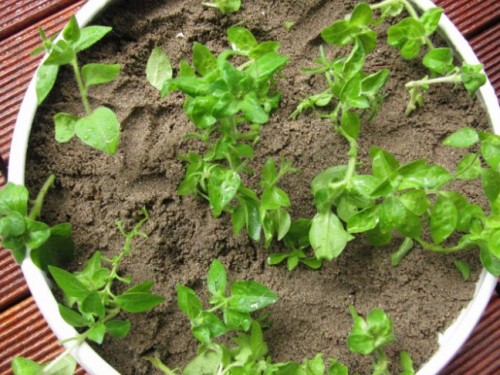How impatiens spread its seeds
Impatiens is a slow-growing plant, and you need to start the last cold-damaged seedlings in spring about three months ago. The germination of impatiens seeds may take up to 21 days and occur within the first two weeks of germination. How do impatiens spread their seeds?

Wind Immortals spread seeds, not by wind, nor by animals, nor by water, but by "self-reliance". When its fruit is split, the pericarp curls inward and protrudes outward, popping out the seeds. There is also a kind of plant called spray melon, when the fruit is about to mature, there is a lot of mucus in the fruit. Once the fruit falls off from the stalk, the pericarp immediately shrinks, causing a lot of pressure, and the mucus and seeds are ejected from the stalk together. Can shoot as far as 5-6 meters!
Some gardeners who save money may try to broadcast through the seed tray and then transplant the saplings, once they grow new leaves, but you will reduce the chances that if you start the seed, shock yourself in individual pots or six packets of cells. You have to transplant seedlings there anyway, so you may start them in their final home. Seeds that do not germinate any empty cells are a small price to pay for healthy, sturdy impatiens.
Planting impatiens seeds is a slow process, but a simple one. Fill the wet commercial seeds and start stirring, leaving half an inch of space between the top of the soil and the edge of the grower with each cell. Put the cell on a tray and fill it with water on the tray. Allow the combination to absorb the moisture of the mixture from the bottom to the top. Remove the tray and pour the rest of the water.
Put the two seeds on the soil of each unit and sprinkle them with dust and mix them with light. The cells at the top of the mist use clear water. The plastic covers the cells to keep moisture and put it in a bright spot to sprout.
Once the seed has germinated and produced a pair of leaves, remove the plastic and fill the tray with cells in a sunny south window. If you don't provide a bright window, plant impatiens under fluorescent lights 16 hours a day.
Some garden experts believe that impatiens seeds do need an initial burst of sunlight to wake up the seeds, they grow stout, if you are strong and then move them to a dark area. The experiment uses this theory to leave the seeds found two days ago in a sunny window. Then, sow the seeds, stir, cover and keep fresh, and move them to a dark place to germinate.
Impatiens fruit will also crack, it is more powerful than sorrel, is the seed bullet in all directions, can also be regarded as another example of mechanical transmission of seeds.
Plants are elves in nature. In order to reproduce, they spread their own seeds with their own unique wisdom in evolution, some with the help of natural fall, some with the help of wind, and some with the help of animal dung and animal fur. However, it is rumored that when impatiens spreads its own seeds, it uses mechanical ejection to eject the seeds in an instant. So is it true?
To this end, the CCTV financial reporter came to the Institute of Botany of the Chinese Academy of Sciences to verify this rumor. Impatiens, also known as henna, used to be used by folk women to paint their nails with beautiful colors. Through careful observation, the reporter found that impatiens looks nothing special, neither colorful, nor strange fragrance, except for the oval spherical objects hanging from the flower stalks, the others are no different from ordinary flowers.
And these globular objects are the places where impatiens keep their seeds, which are called capsules. Now is the impatiens seed mature season, the capsule has begun to swell up. So can impatiens, which looks so ordinary at present, really spread seeds in a strange way of ejection? The reporter waited for 2 hours, but no seeds were ejected, so he could not help but doubt the netizens' statement.
Wang, a teacher from the Institute of Botany of the Chinese Academy of Sciences, told reporters: "Impatiens can indeed eject seeds on their own, and they can also eject their seeds under the stimulation of external forces. When the fruit of impatiens is ripe enough, such as the blowing of the wind and the beating of raindrops, it will cause its fruit to explode. in fact, under natural conditions, the touch of small animals walking through the flowers can lead to the explosion of its fruit as well as the touch of the hand.
So the reporter tentatively touched the capsule with his hand, and at this time a magical scene appeared. Just when the reporter was pinching the capsule, suddenly the seed ejected from the capsule at a sudden speed. Then the reporter stimulated several capsules with the help of other ways, and the same thing happened again.
Although in the process of waiting, the reporter did not observe the phenomenon of impatiens ejecting seeds independently, but through external stimulation, the capsule of impatiens did eject the seeds. So what principle does impatiens use to eject its own seeds? Why did you choose this way to spread the seeds?
Teacher Wang said, "the fruit of impatiens is made up of many split peels. When these fruit slices are ripe, there is a mechanical tension, inward tension. Under external touch or external stimulation, he will pop open. Each split piece will be rolled up, and in the process there will be a certain amount of elasticity to bounce the fruit out." The growth conditions in the wild are generally humid and dark, and it is generally difficult to have a good mode of transmission, so after long-term evolutionary selection, it chooses to eject the seeds on its own. So, is impatiens the only plant that uses ejection to spread seeds?
Zhang Huijin, a senior engineer at the Institute of Botany of the Chinese Academy of Sciences, told reporters: "in addition to impatiens, there are many plants that use ejection or jet to send seeds, such as spray melons, some plants of Leguminosae, and plants of Viola. They all spread by catapult."
Time: 2019-06-11 Click:
- Prev

Modeling method of snow bonsai in June
Different tree species have their own ways to play! As far as June snow is concerned, its Tigen is the most interesting, so I suggest: truncate the upper branches, divide the primary and secondary, lift the roots up, take your time, you can't hurry to play with bonsai! 1. Processing: June snow is generally modeled and processed by the method of cutting and binding.
- Next

Breeding method of snapdragon
Antirrhinum propagation methods are sowing and cuttage method. Seeding seedbed to choose loose soil structure, low groundwater level, good drainage, rich in organic matter sandy loam, the seedbed will be watered thoroughly, the seeds will be mixed with fine sand 1:4 sprinkled on the substrate. Cuttings in spring and autumn, while drilling side insert cuttings, compaction morning and evening after spraying water.
Related
- Fuxing push coffee new agricultural production and marketing class: lack of small-scale processing plants
- Jujube rice field leisure farm deep ploughing Yilan for five years to create a space for organic food and play
- Nongyu Farm-A trial of organic papaya for brave women with advanced technology
- Four points for attention in the prevention and control of diseases and insect pests of edible fungi
- How to add nutrient solution to Edible Fungi
- Is there any good way to control edible fungus mites?
- Open Inoculation Technology of Edible Fungi
- Is there any clever way to use fertilizer for edible fungus in winter?
- What agents are used to kill the pathogens of edible fungi in the mushroom shed?
- Rapid drying of Edible Fungi

